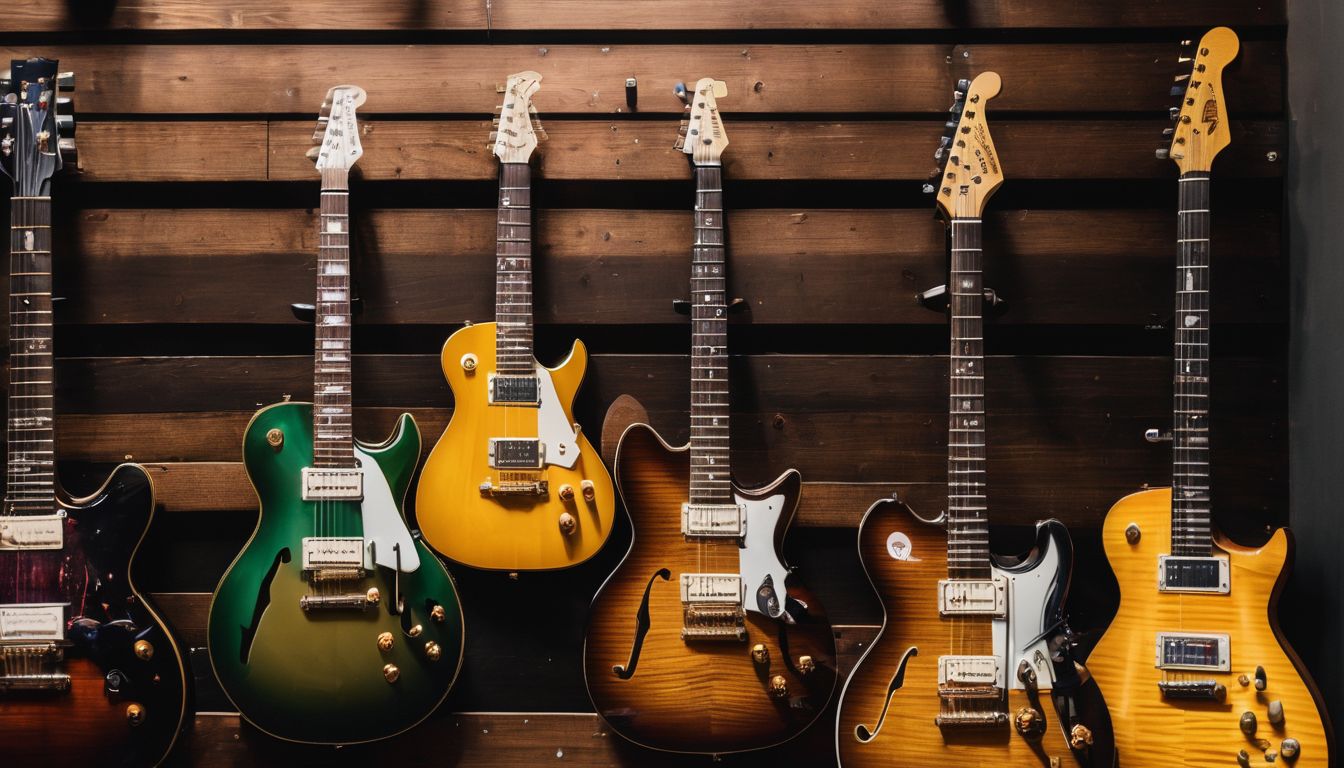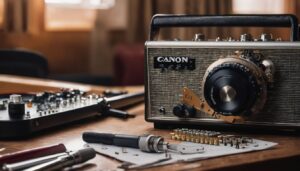As an Amazon Associate I earn from qualifying purchases.
Struggling to understand the various types of electric guitars that crowd today’s music market? It’s a fact: The variety can be mind-boggling, from body styles like Stratocaster or Les Paul to different guitar construction such as solid body or semi-hollow.
Fear not! Our detailed guide will clear up your confusion by breaking down each type in an easy-to-understand way. So stay tuned, because mastering this knowledge could bring you a giant step closer to finding your dream guitar.
Table of Contents
Iconic Electric Guitar Body Styles
The Stratocaster, Super Strat, Telecaster, Offset guitars (Jaguar, Mustang, Jazzmaster), Les Paul style guitars, and SG body type are some of the iconic electric guitar body styles.
Stratocaster
The Stratocaster, popularized by the iconic brand Fender, holds a prominent place in music history due to its unique design and sound. This guitar features a double-cutaway body shape that allows easier access to higher frets while offering excellent balance and comfort.
Its three single-coil pickups produce bright and clear sounds, making it versatile for various genres like rock, blues, and pop. Musicians often favor the Stratocaster for its ability to deliver both sharp lead tones and crunchy rhythm sounds with utmost precision.
Furthermore, the traditional use of alder or ash as tonewood provides a broad spectrum of tone dynamics – from rich lows to crisp highs.
Super Strat
Super Strat guitars are a popular type of electric guitar body style. They are essentially modified versions of the classic Fender Stratocaster, designed to provide even more versatility and tonal options for players.
Super Strats typically have features like a double-cutaway body, tremolo bridge, and HSS (humbucker-single-single) pickup configuration. These additions allow for heavier rock tones that can handle high gain settings while still retaining the crispness and clarity associated with single-coil pickups.
Super Strats are highly sought after by players who want a versatile instrument capable of handling various genres and playing styles.
Additionally, Super Strats often feature fast-playing necks with access to all 24 frets, making them well-suited for shredding and lead guitar work. The combination of these design elements makes Super Strats an excellent choice for intermediate to advanced players looking for an electric guitar that can deliver a wide range of tones without sacrificing playability or comfort.
Telecaster
The Telecaster is one of the most iconic electric guitar body styles. Known for its sleek and simple design, it features a solid body construction that produces a bright and twangy tone.
The Telecaster has two single-coil pickups, which deliver crisp and clear sounds. It is favored by many musicians in various genres, from country to rock. With its distinctive look and versatile sound, the Telecaster remains a popular choice among guitar players worldwide.
Offset Guitars (Jaguar, Mustang, Jazzmaster)
Offset guitars, such as the Jaguar, Mustang, and Jazzmaster, have a distinct shape that sets them apart from other electric guitar body styles. These guitars feature offset waist contours, meaning the bass side of the body is slightly larger than the treble side.
This unique design contributes to their comfortable playability and distinctive sound. Offset guitars are known for their versatility in genres like indie rock, alternative rock, and jazz due to their wide range of tone controls and pickup configurations.
Whether you’re looking for smooth cleans or gritty distortion, offset guitars offer a unique playing experience that stands out from the crowd.
Les Paul Style Guitars
Les Paul style guitars are known for their iconic design and rich, warm sound. They typically have a solid body construction with a single-cutaway shape and a carved top. Les Paul style guitars often feature humbucking pickups, which provide a thicker tone compared to single coil pickups.
With their distinct look and versatile sound, Les Paul style guitars are favored by many guitarists across various genres, from rock to jazz to blues. Whether you’re a beginner or an experienced player, these guitars offer an excellent balance of playability and sonic versatility.
SG Body Type
The SG body type is another iconic design in the world of electric guitars. It was introduced by Gibson in 1961 and quickly gained popularity among rock and blues guitarists. The SG, which stands for “solid guitar,” features a double-cutaway design with thin, contoured edges that make it comfortable to play.
Its lightweight mahogany body produces a warm tone with rich sustain. The SG also has a slim neck profile that allows for fast and smooth playing, making it a favorite choice for guitarists who prefer speed and agility on the fretboard.
With its distinctive look and versatile sound, the SG body type continues to be an enduring symbol of rock ‘n’ roll attitude.
Other Iconic and Weird Shaped Guitars
The world of electric guitars is full of iconic and unique shapes. Aside from the classic body styles like Stratocasters, Telecasters, Les Pauls, and SGs, there are also other standout designs that have become famous in their own right.
For example, you have guitars like the Flying V and Explorer with their distinct angular shapes, as well as the quirky-shaped offset guitars such as Jaguars, Mustangs, and Jazzmasters.
These unconventional designs not only offer a different aesthetic appeal but can also bring out different tones and playing experiences for guitarists who dare to be different.
Types of Electric Guitar Construction
There are three main types of electric guitar construction: solid body, semi-hollow, and hollow body. Find out more about these different styles and how they affect the tone of the instrument.
Solid Body Guitars
Solid body guitars are a popular choice among electric guitar players. These guitars have a solid, single-piece body made of wood or other materials. The solid construction eliminates any hollow spaces, resulting in a more focused and powerful tone.
Solid body guitars are known for their versatility and ability to handle different playing styles and genres. They are commonly used in rock, metal, and blues music due to their ability to produce heavy distortion and sustain.
Some well-known examples of solid body guitars include the Fender Stratocaster, Gibson Les Paul, and PRS Custom 24.
Semi-Hollow Guitars
Semi-hollow guitars are a popular choice for musicians who want the best of both worlds. These guitars have a solid center block running through the body, which helps to reduce feedback and increase sustain.
However, they also have hollow wings or sides, giving them a more resonant and open sound compared to solid body guitars. This combination creates a unique tone that is warm and full-bodied, making semi-hollow guitars suitable for various genres like blues, jazz, rockabilly, and indie rock.
The design of semi-hollow guitars allows for greater versatility in terms of playing styles and tones. They can produce rich clean tones with excellent clarity when played unplugged or through an amplifier.
When overdriven or distorted, they deliver a smooth and creamy tone with just the right amount of bite. The hollow portions provide additional resonance and acoustic qualities while maintaining some stability from the solid center block.
Hollow Body Guitars
Hollow body guitars are a popular choice among musicians looking for warm and full-bodied tones. These guitars are crafted with a hollow chamber in the body, which allows for greater resonance and acoustic-like qualities.
The hollow design also gives the guitar a lightweight feel and adds depth to the sound produced. Hollow body guitars are ideal for playing jazz, blues, and rockabilly genres due to their rich tonal characteristics and ability to produce smooth sustain.
They often feature F-holes on the top, similar to those found on violins, which enhance the overall projection of sound. Whether you’re a professional guitarist or just starting out, a hollow body guitar can be an excellent addition to your collection if you’re seeking versatility and vintage-inspired tones.
Different Pickup Types and Configurations
Different Pickup Types and Configurations can greatly impact the sound of an electric guitar.
Single Coil
Single coil pickups are a common type of pickup found in electric guitars. They are known for their bright and clear tone, which is characterized by a strong midrange and crisp attack.
Single coils are typically made up of one magnet and one coil of wire, hence the name “single coil.” These pickups produce a distinct sound that is often associated with genres such as blues, country, and surf rock.
Some iconic single coil-equipped guitar models include the Fender Stratocaster and Telecaster. If you’re looking for that classic vintage tone or want to capture the twangy sound of country music, single coil pickups might be the right choice for you.
Humbucking Pickups
Humbucking pickups, also known as humbuckers, are a type of electric guitar pickup that were designed to eliminate the unwanted hum or noise often associated with single-coil pickups.
They do this by using two coils wound in opposite directions and connected in series. The main advantage of humbuckers is that they offer a thicker and warmer tone compared to single-coils.
They produce a higher output signal, which makes them ideal for heavier genres such as rock and metal. Humbuckers also have a fatter sound with more sustain, making them popular among players who prefer a fuller and more powerful sound.
In terms of construction, humbuckers are wider and bulkier than single-coils due to the addition of the second coil. This results in a different visual look on the guitar’s body where they are mounted.
P90 Pickups
P90 pickups are a popular choice among guitarists due to their unique sound. These single coil pickups have a wider, fatter tone compared to traditional single coils. They produce a rich and warm sound with plenty of midrange punch.
P90 pickups provide a nice balance between the clarity of single coils and the beefiness of humbuckers. They are commonly found in guitars like Gibson’s Les Paul Junior and Special models, offering players a versatile range of tones for various styles of music.
Whether you’re playing blues, rock, or even jazz, P90 pickups can add depth and character to your electric guitar sound.
Active Pickups
Active pickups are a type of pickup commonly found in electric guitars. Unlike passive pickups, which rely solely on the vibrations of the guitar strings to create an electrical signal, active pickups have built-in preamps that boost and shape the signal.
This results in a stronger output, increased clarity, and enhanced sustain. Active pickups are often chosen by musicians who play high-gain styles of music such as metal or hard rock, as they can provide greater control over tone and help minimize unwanted noise or feedback.
Some popular brands that offer active pickups include EMG and Seymour Duncan.
Other Pickup Types
Other than single coil, humbucking, P90, and active pickups, there are a few other types of pickups that you might come across when exploring electric guitars. One example is the lipstick pickup, which gets its name from its unique shape that resembles a tube of lipstick.
These pickups have a bright and clear tone with a slightly twangy sound. Another type is the rail pickup, which consists of two parallel metal rails instead of individual pole pieces.
Rail pickups offer a balance between single coil clarity and humbucker warmth. Finally, there’s the piezo pickup, which is commonly found on acoustic-electric guitars. Piezo pickups pick up vibrations from the guitar’s bridge saddle to produce an accurate representation of the instrument’s natural sound when amplified.
Overview of Tonewood Types and Neck Construction
Looking to dive into the world of electric guitars but don’t know where to start? Well, you’re in luck! In this article, we’ll break down the different types of electric guitars and help you find the perfect one for your needs. Did you know that there are various body styles like Stratocaster, Telecaster, Les Paul, and more? We’ll explore these iconic designs and discuss their unique features. Additionally, we’ll delve into the different types of construction such as solid body, semi-hollow, and hollow body guitars. So whether you’re a beginner or an experienced player, get ready to discover your dream electric guitar in just a few clicks!
Guitar Tonewoods
Guitar tonewoods play a crucial role in determining the sound and tone of an electric guitar. Different types of wood are used for the body, top, neck, and fretboard of guitars. Common tonewoods include mahogany, maple, alder, ash, rosewood, and ebony.
Each wood type has its own unique characteristics that contribute to the overall sound quality of the instrument. The choice of tonewood affects factors such as sustain, resonance, warmth or brightness of the tone produced by an electric guitar.
It is important to consider the tonewood when choosing an electric guitar that matches your preferred sound and playing style.
Neck Construction (Bolt-On, Set Neck, Neck-Through)
Electric guitars come in different neck constructions, each with its own unique characteristics. One common type is the bolt-on neck construction, where the guitar neck is attached to the body using screws or bolts.
This allows for easy repair and replacement of the neck if needed. Another type is the set neck construction, where the neck is glued into a pocket on the guitar body. This provides better sustain and resonance but makes repairs more challenging.
Lastly, there’s the neck-through construction, which involves making a single piece of wood that extends from headstock to bridge, providing excellent stability and sustain. Each type offers its own benefits and considerations for players to consider when choosing their electric guitar.
Neck Profiles and Frets
Different electric guitars have different neck profiles and frets, which greatly affect the playability and feel of the instrument. Neck profiles refer to the shape of the back of the neck, ranging from slim and fast to chunky and rounded.
Frets are thin metal strips embedded along the fingerboard that divide it into sections, allowing you to press down on them to change pitch. Some guitars have wider or narrower frets depending on personal preference.
Both neck profile and fret size can impact how comfortable a guitar feels in your hands, so it’s important to find one that suits your playing style.
Conclusion
There are many different types of electric guitars available to choose from. From iconic body styles like the Stratocaster and Les Paul, to different construction types like solid body and hollow body guitars, there’s something for every player.
With various pickup options and tonewoods, each guitar has its own unique sound and feel. So whether you’re a beginner or an experienced musician, explore the world of electric guitars and find one that suits your style.
FAQs
1. What are the different types of electric guitars?
The different types of electric guitars include solid body, semi-hollow body, and hollow body guitars.
2. How do solid body electric guitars differ from other types?
Solid body electric guitars have a solid piece of wood as their main body, which provides a more focused sound and reduces feedback.
3. What are the advantages of semi-hollow body electric guitars?
Semi-hollow body electric guitars offer a blend of acoustic and electric tones, with a warmer sound and enhanced resonance.
4. Are there any specific genres or playing styles associated with certain types of electric guitars?
While there are no strict rules, certain guitar types like the Stratocaster and Telecaster are commonly used in rock music, while jazz players often prefer archtop hollow-body models for their warm tones.
Amazon and the Amazon logo are trademarks of Amazon.com, Inc, or its affiliates.





